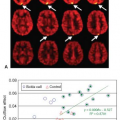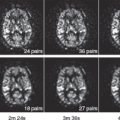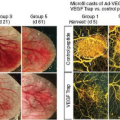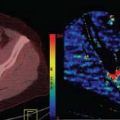Migraine and Seizures
Hongwu Zeng
Christian La
Veena A. Nair
Vivek Prabhakaran
Howard A. Rowley
Migraine and seizures are two very common neurologic conditions. Although fundamentally different entities, both conditions are characterized by episodic symptoms and transient neurovascular phenomena. Perfusion imaging may show dynamic changes from the prodromal phase to ictus to postictal recovery. This chapter reviews the key clinical features, pathophysiologic theories, and perfusion patterns observed.
Clinical Aspects of Migraine
Migraine is a common chronic neurologic disease, characterized by episodic attacks of headache and associated symptoms (e.g., nausea, vomiting),1 affecting 12% of adults in Western countries, with a prevalence three times higher in women than in men.2 A typical migraine headache is unilateral and throbbing in nature, lasting from several minutes to a few days. Some of the associated symptoms include nausea, vomiting, photophobia, and phonophobia. Symptoms are usually aggravated by daily activities such as walking and climbing stairs. The diagnosis of migraine is made based on clinical criteria, with neuroimaging used in some cases to exclude alternative, more sinister causes of headache.3 According to the International Headache Society, migraine is divided into two major subtypes: migraine with aura, where a perceptual disturbance is experienced before the onset of the headache, and migraine without aura.1 The aura can be visual, sensory, or motor and can involve language or brainstem disturbance. The most commonly perceived aura is a visual disturbance, often the perception of flashing lights, squiggly lines, or scintillating scotomas in the visual field. Symptoms of aura usually develop over 5 to 20 minutes and last less than 60 minutes. The headache frequently follows within 60 minutes of the end of the aura. Sometimes, migrainous auras may occur with little or no headache. To be classified as migraine with aura, the patient has to have had at least two migraine attacks with aura, regardless of the number of attacks they have had without aura. Patients with migraine who have fewer than two attacks with an aura are categorized as migraine without aura.
Migraine can be divided into four symptomatic phases: prodrome, aura, headache, and postdrome, although not all phases are necessarily experienced. Additionally, the phases and the symptoms experienced during attacks can vary from one migraine attack to another in the same person. The time period between the two migraine attacks is referred to as the interictal phase.
Pathophysiology of Migraine
Migraine is characterized by hyperexcitability of brain networks, which can be triggered by a variety of stimuli (e.g., menstruation, fragrances, and light) or may arise spontaneously. Although the exact mechanism is unclear, migraine is generally considered to have an inherited basis, at least for some subjects. An extensively studied class of migraine, familial hemiplegic migraine is an autosomal dominant disorder characterized by attacks of transient hemiparesis associated with a migraine headache.4
The pathophysiology of migraine is characterized by both abnormal neuronal excitability and vascular events. From a clinical standpoint, positive phenomena (such as an aura with tingling or flashing lights) suggest migraine and distinguish it from other conditions where negative phenomena (loss of function) are the main manifestation (e.g., fixed visual scotoma or paralysis from stroke or tumor). Currently, there are three main theories of migraine: vasogenic theory, cortical spreading depression (CSD) theory, and brainstem generator theory.5,6,7,8
Vasogenic Theory
According to the once widely accepted vasogenic theory, the onset of migraine aura is caused by transient ischemia induced by vasoconstriction. The headache itself develops from subsequent reactive vasodilation of intracranial and extracranial arteries with activation of vascular nociceptors.6,9 This theory explains the headache’s throbbing quality and the relief of symptoms by ergotamines, a regulator of blood vessel tone. However, there is emerging contradictory evidence. Serial magnetic resonance imaging (MRI) shows that affected cortical regions do not correspond to a single vascular territory and this disagrees (somewhat) with a primarily vascular etiology.10 Furthermore, there is no clear evidence for a significant increase in the diameter of the middle cerebral artery during migraine attacks. This traditional vasogenic theory remains unproven for most migraine patients.8
Cortical Spreading Depression Theory
CSD theory was proposed later. This theory asserts that a primary neural event, CSD, triggers subsequent vascular reaction.6 CSD triggers vasoconstriction in specific cortical regions (most frequently visual cortex in visual migraine), which results in aura, followed by dilation of brain vessels
(e.g., meningeal vessels), causing the headache. So overall this can be described in three phases:
(e.g., meningeal vessels), causing the headache. So overall this can be described in three phases:
CSD phase: A wave of electrophysiological hyperactivity followed by a wave of inhibition, originating usually from the visual cortex, creates an electrical spreading depression wave, which progresses across the cerebral cortex at a rate of approximately 2 to 5 mm per minute.
Aura phase: Evidence from most animal studies show cortical spreading hyperemia during CSD, followed by sustained vasoconstriction or cortical oligemia (aura phase), and finally vasodilation (headache phase). In human studies, during visual auras, perfusion measurements of cortical blood flow decreased by 15% to 53%, cerebral blood volume decreased by 6% to 33%, and mean transit time increased by 10% to 54% in the occipital cortex contralateral to the aura.11
The fact that about two-thirds of patients with migraine do not experience an aura conflicts with the idea of CSD as the primary event. Pietrobon and Striessnig6 suggested that CSD may also occur in migraine patients without aura, possibly because it originates in a clinically silent area of the cerebral cortex. This claim has neither been proven nor excluded.
Brainstem Generator Theory
This theory proposes that migraine aura and headache are considered parallel rather than sequential processes. The primary cause of migraine headache is thought to be an episodic dysfunction in brainstem nuclei, which are involved in the central control of nociception. A number of studies have provided evidence for brainstem involvement. Increased cerebral blood flow (CBF) has been noted in several areas of the dorsal rostral brainstem during migraine attacks.12,13 Positron emission tomography (PET) reveals that the dorsal raphe nucleus and locus coeruleus show maximal CBF increase in patients with migraine without aura.12 The red nucleus and the substantia nigra were also the sites of maximum CBF increase in migraine patients studied with blood oxygenation–level dependent functional MRI during visually triggered migraine episodes.13
The pathophysiology of migraine is incompletely understood. It is currently believed that both vascular and neuronal mechanisms are involved. A widely accepted scenario consists of brain-initiated events evolving into CSD, which in turn activates the trigeminal nerve to cause headaches.6,14 Just as peri-infarction depolarizations are thought to cause secondary ischemia in animal stroke models, CSD in migraine incites oligemia, at least in some headache patients. Migraine patients with aura may commonly show hypoperfusion early in the attack, while those who have migraine without aura less commonly show perfusion changes.
Perfusion in Migraine
Perfusion alterations in migraine are based on the theory that increased neuronal activity and neurovascular coupling are linked to changes in blood flow. The most common perfusion pattern of migraine is hypoperfusion in prodrome phase, and either hypoperfusion or hyperperfusion in the aura or silent aura phase, based on aura severity. In the headache phase, hyperperfusion is present but decreases gradually; and in postdrome and interictal states, hypoperfusion has been demonstrated in some cases. In the majority of reported clinical cases, hypoperfusion has been present (Figs. 53.1 and 53.2). Perfusion changes in migraine generally fall into the benign oligemia range, with time maps (time to peak, time to maximum, mean transit time [MTT]) most sensitive for detection.15 These abnormal perfusion patterns can affect the hemisphere contralateral or ipsilateral to the aura or/and cephalagia.13,16,17,18,19,20
The perfusion pattern will be described accordingly in five phases.
Prodrome phase: Also called preheadache, in which symptoms often begin hours or days before migraine headache pain. Studies show hypoperfusion in this phase.
Aura phase: Immediately precedes the headache; in this period, symptoms derive from dysfunction of the cerebral cortex or brainstem. There are two types of aura phases described: Typical aura phase and atypical aura phase.
Typical aura phase is the most common type, which usually develops gradually over 5 to 20 minutes and lasts for less than 60 minutes. As the duration of aura in this type is usually short, perfusion examples have only rarely been captured in clinical practice. The hemispheric pattern observed corresponds to the dysfunctional cortex producing aura, most frequently seen in the posterior cerebral regions. The typical aura phase is characterized by hypoperfusion (CBF decrease, MTT increase, and cerebral blood volume decrease)20 and gradually returns to baseline.
The prolonged or persistent form of atypical aura lasts more than 24 hours and is often seen in hemiplegic migraine. Aura and headache usually both localize to the dysfunctional hemisphere, producing abnormal regional perfusion with corresponding contralateral hemiplegia,21 but there can also be bilateral perfusion abnormalities in this phase.22 Affected regions might vary even in same patient for different migraine attacks.23 The observed patterns include all possibilities, depending on the exact timing of the imaging studies: hyperperfusion (frequently seen in hemiplegic migraine),23,24 hypoperfusion (minor type),22,25 or normal perfusion.25
Headache phase: The classic headache is a one-sided throbbing or pounding pain, usually lasting between 4 to 72 hours.
Headaches lasting longer than 72 hours are called status migrainosus. This phase is usually characterized by hyperperfusion24,26,27 in the hemisphere ipsilateral to the headache but can also be bilateral. Affected cerebral areas migrate from the posterior regions in the aura phase to anterior regions (parietal frontal lobe often affected) in the headache phase. The distribution is typically regional and does not conform to a single classical arterial territory (Fig. 53.3). Acquiring computed tomography (CT) and MRI perfusion can be challenging in this phase due to patient discomfort.

FIGURE 53.2. A: A 19-year-old woman presented with transient generalized weakness and new-onset severe headaches. Although the headache had responded to the therapy by the time of magnetic resonance imaging, the perfusion parameter maps obtained early after presentation demonstrate significant hypoperfusion in the right temporal and occipital lobe: prolonged mean transit time (MTT; first moment transit time [FMT]), decreased cerebral blood flow (CBF), and preserved cerebral blood volume (CBV). B: Follow-up study of (A) with headache and weakness resolved completely. Computed tomography perfusion done 13 days later shows that perfusion patterns had completely normalized, as expected for a migraine.
Stay updated, free articles. Join our Telegram channel

Full access? Get Clinical Tree

 Get Clinical Tree app for offline access
Get Clinical Tree app for offline access







